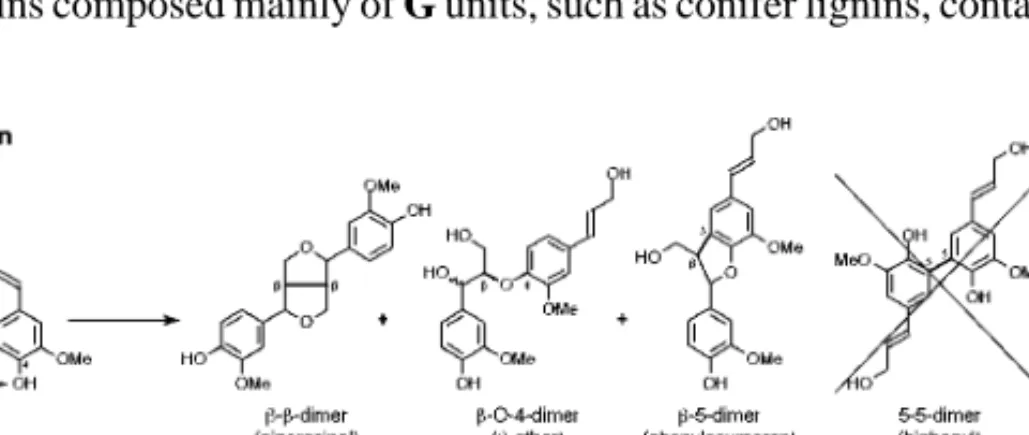Lignin is, after cellulose, the second most widespread terrestrial biopolymer, accounting for approx. 30% of the organic carbon in the biosphere. Lignin is essential for structural integrity of the cell wall and stiffness and strength of the stem (23, 71). Likewise, the biochemical processes leading to the dehydrogenation of the monolignols in the cell wall and their polymerization and deposition are fields of active discussion.
The relative abundance of the various bonds largely depends on the relative contribution of a particular monomer to the polymerization process. Lignin deposition proceeds in several phases, each preceded by carbohydrate deposition, and begins at the cell corners in the mid-lamellar and primary wall region when S1 formation has begun. However, because it occupies a larger portion of the wall, the secondary wall has the highest lignin content.
In the middle lamella and the primary wall, lignin forms spherical structures, whereas in the secondary wall, lignin forms lamellae that follow the orientation of the microfibrils. The first revision of the pathway arose from the observation that expression of caffeoyl-CoA O -methyltransferase (CCoAOMT) coincided with lignin deposition in differentiating tracheal elements in zinnia (148). CAD is a multifunctional enzyme that, at least in vitro, catalyzes the final reduction of the cinnamaldehydes to the corresponding alcohols.
However, in plants downregulated for 4CL, CCoAOMT and CCR, the incorporation of other phenols into the lignin polymer is likely to be the cause of the xylem discoloration.

TRANSPORT OF MONOLIGNOLS
In addition to contributing to our understanding of lignin biosynthesis and structure, the same transgenic lines have also shown that lignin is important for the structural integrity of the cell wall. Plants downregulated in C3H, CCoAOMT and CCR all showed a reduction in lignin content associated with vascular collapse and altered growth, phenotypes that can vary significantly depending on developmental and environmental conditions (104, 105). Such collapsed vessels have been studied in detail in CCR-downregulated tobacco and Arabidopsis irx4 mutants and have an extensive S2 secondary wall with individualized cellulose microfibrils, indicating an important role for lignin as cohesion between cellulose microfibrils.
However, in some cases, reduced lignin content is not associated with growth abnormalities (80) and, in the case of 4CL downregulation in aspen, even with increased growth, showing that lignin content per se is not essential for the structural integrity of the cell wall. and that the reduced lignin content can be compensated by other cell wall components (65). The increase in cellulose linked to a decrease in lignin observed in 4CL-downregulated poplars does not appear to be a general phenomenon; irx4 mutants deficient in CCR have less lignin but no increase in cellulose (71). According to early studies with radiolabeled monolignol precursors, lightening of the cell wall is hypothesized to continue after cell death (102).
These findings are now supported by experiments on the zinnia cell system, showing that the lignification of tracheal elements that have undergone programmed cell death still progresses through the supply of monolignols from the surrounding xylem parenchyma cells (63).
DEHYDROGENATION
POLYMERIZATION
Radical Generation and Radical Coupling
Polymerization Process
Such DHP experiments have shown that the structure of lignin depends on the rate of monomer supply, the rate of radical generation, the presence of polysaccharides in the DHP mixture, and the presence of the growing lignin polymer (53). The accepted model of lignin polymerization based on simple chemically controlled combinatorial coupling reactions has recently been challenged. Instead, this group proposes a strong biological control over the outcome of phenoxy radical coupling in vivo.
The new theory arose from the discovery of a fascinating class of conductor proteins involved in lignan biosynthesis (32); lignans are dehydrodimers of monolignols and are usually optically active. The first directing protein discovered directed the dimerization of coniferyl alcohol radicals to produce an optically active lignan, pinoresinol. The finding was extrapolated to lignification, suggesting that such proteins would logically be responsible for specifying the exact structure of the lignin polymer, aligning lignins with proteins and polysaccharides that are more carefully biosynthesized (31, 81).
However, no strong argument requires a role for conductors in lignification, and numerous facts do not fit the proposed model for absolute structural control over lignification. Reverse genetics will show whether conductors play any role in lignin biosynthesis in addition to their involvement in lignan biosynthesis.
Nucleation Sites
BIOTECHNOLOGY
Through the combined expression of these three angiosperm genes (F5H, COMT and SAD) in gymnosperms, it should be possible to divert coniferaldehyde and coniferyl alcohol towards the synthesis of S units and improve lignin extractability. Transgenic poppers downregulated to 4CL also hold great promise for the pulp industry; they have less lignin and more cellulose, and they grow taller for as yet unknown reasons. Tobacco and alfalfa, downregulated for CAD, had higher in situ disappearance of cell walls (9, 12), and cell walls prepared from the Arabidopsis ref8 mutant deficient in C3H and with lignin composed almost exclusively of H units are more susceptible to polysaccharide hydrolase than wild type (46).
Several quantitative trait loci for lignin composition in eucalyptus coincide with map positions of genes involved in lignin biosynthesis (51), and maize bm mutants with altered agronomic performance have defects in monolignol biosynthesis genes paving the way for the use of molecular markers in marker -supported selection programs.
CONCLUSIONS AND PERSPECTIVES
Effect of modification of O-methyltransferase activity on cell wall composition, ultrastructure and degradability of transgenic tobacco. Deposition process and structural diversity of lignin in the plant cell wall of sugarcane and rice studied by ultraviolet microscopic spectroscopy. Specific localization of a glycine-rich protein in protoxylem cells of the vascular system.
Identification of the structure and origin of thioacidolysis marker compounds for cinnamyl alcohol dehydrogenase deficiency in angiosperms. Effects of trans-cinnamic acid on expression of the bean phenylalanine ammonia lyase gene family. Developmental expression and biochemical analysis of the Arabidopsis atao1 gene encoding an H2O2-generating diamine oxidase.
Developmental regulation of the H2O2-producing system and of a basic peroxidase isoenzyme in the Zinnia elegans lignifying xylem.
C ONTENTS